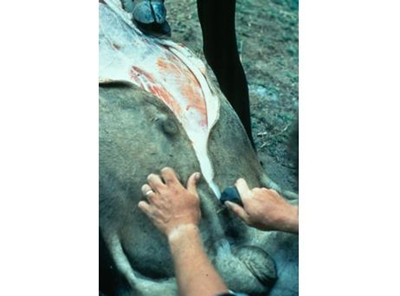Of course we've no idea what the maker of our handaxe might have said, but it seems probable that he would have had roughly the language abilities of a seven-year-old child. But whatever the level, this early speech would clearly have been the beginnings of a quite new capacity for communication - and that would have meant that people could sit down to exchange ideas, plan their work together or even just to gossip. If you can make a decent handaxe like this one, it's a good bet that you're well on the way to something we would all recognise as society.
當然我們無法知道當時我們那制造石斧的祖先可能說出什么,但極有可能他當然已經擁有約等同于七歲左右小孩子的語言能力。然而無論他當時水平如何,顯然這種早期的語言是一種全新溝通能力的開始;同時這也意味著同時的人類已經能夠坐下來交流思想,或共同計劃下大家的工作,或就只是單純的閑聊拉呱。假如你有能力制造出那么體面的手斧,那么我敢打賭當已經相當具有某些我們現代社會能夠認可的共性。
So, 1.2 million years ago, where are we? We can make tools like our handaxe, that help us control our environment and in fact transform it - the handaxe gives us not just better food, but can also skin animals for clothing and strip branches for fire or shelter.
所以一百二十萬年前,我們究竟在哪里?我們能夠制造出像這種手斧一樣的工具,能有效幫我們控制我們的環境,甚至改變環境;這手斧不僅可以給我們提供更好的食物,而且能剝獸皮來當衣服,扒樹皮來取火或者建造庇護場所。
Not only this; we can now talk to each other and we can imagine something that isn't already in front of us. What next? The handaxe is about to accompany us on a huge journey; because with all these skills, we're no longer tied to our immediate environment.
不僅如此,我們現在已經能夠彼此交流,能夠想象出那些還沒發生在我們面前的事物。下一步呢?這手斧將伴隨著我們繼續我們的偉大征途,因為擁有這些技能,我們將不再依賴于眼前的直接環境。
If we need to - even if we just want to - we can move. Travel is possible, maybe even desirable, and we can spread beyond the warm savannahs of Africa and survive, perhaps even flourish, in a colder climate.
假如我們有需要,甚至只是我們有意愿,我們可以遷徙。現在長途旅行已經可能了,也許甚至是更可取的,我們可以超越這溫暖的非洲大草原,在更寒冷的氣候里存活,甚至繁衍生息。
The handaxe is our passport to the rest of the world, and in the study collections of the British Museum you can find handaxes from all over Africa - Nigeria, South Africa, Libya - but also from Israel and India, Spain and Korea - even from a gravel pit near Heathrow airport.
這手斧是我們探索世界其他各角落的通行證。仔細觀察下大英博物館里的各種藏品,你就能夠找到出土于非洲各地的手斧——尼日利亞的,南非的,利比亞的;同時你還能找到來自以色列、印度、西班牙、韓國等地;甚至在希思羅機場附近的礫石坑也有手斧的出土呢。
And as they moved north, these early handaxe-makers became the first Britons. Nick Ashton has been excavating on the Norfolk coast
隨著他們的北遷,這些早期的手斧制造者們其中有些成為了首批英國人。尼爾·阿什頓在Happisburgh地區的諾福克海岸進行過挖掘:
'In Happisburgh we have these 30-foot (or 9-metre) cliffs, which are composed of these clays and silts and sands, and these were laid down by massive glaciation around about 450,000 years ago, which even reached the outskirts of north London. But it's beneath these clays that a local who was walking his dog found a handaxe, embedded in these organic sediments.
“在Happisburgh那里有大概三十英尺,即九米高的懸崖,由粘土、粉砂及沙石構成;這些地質層都大約形成于四十五萬年前的大規模冰川時期,當時冰川延伸到現倫敦北部的郊區。某天一個當地人在溜狗時,無意發現在一把手斧鑲嵌在這些粘泥層下的有機沉積物中。
But these tools - which were first being made in Africa 1.6 million years ago - arrived in southern Europe and parts of Asia just under a million years ago, and reached Britain somewhere between 600,000 and 500,000 years ago.
這種最早出土于一百六十萬年前非洲地區的工具,在不到一百萬年前抵達了歐洲南部及亞洲部分地區,并且在約五十至六十萬年前抵達了英國地區。












